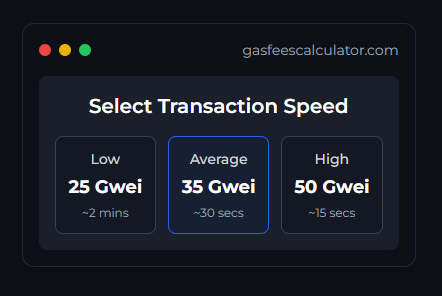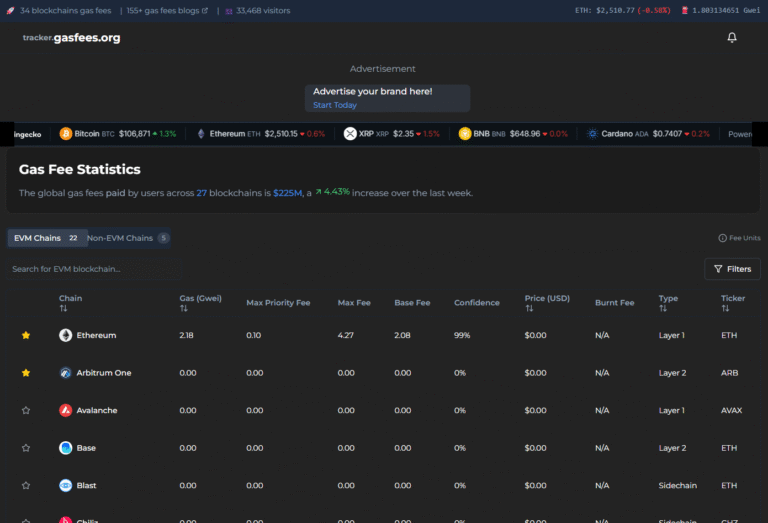
What Are Tezos Gas Fees?

Tezos, a blockchain platform known for its unique self-amendment mechanism, has gained significant attention in the world of blockchain and cryptocurrency.
While Tezos offers a range of features and benefits, it’s essential to understand Tezos gas fees, a fundamental aspect of the network.
In this comprehensive guide, we will delve into what Tezos gas fees are, why they matter, and how they impact users and developers within the Tezos ecosystem.
Tezos: A Brief Overview
Before we dive into the specifics of Tezos gas fees, let’s take a moment to understand what Tezos represents in the blockchain landscape.
Tezos, often referred to as “the self-amending blockchain,” is a decentralized, smart contract platform. It distinguishes itself from other blockchain networks through its ability to evolve and upgrade without hard forks. This self-amendment mechanism, combined with its focus on security and governance, makes Tezos a compelling choice for developers and users alike.
What Are Tezos Gas Fees?
In the context of Tezos, gas fees are transaction fees paid by users to compensate for the computational resources required to execute smart contracts and transactions on the network. These fees serve several essential purposes within the Tezos ecosystem:
- Resource Allocation: Gas fees ensure efficient allocation of network resources. Transactions with higher fees receive priority, ensuring that they are processed promptly while preventing network congestion.
- Security: Gas fees play a crucial role in network security by deterring spam and malicious activities. They make it economically impractical for attackers to flood the network with unnecessary transactions.
- Compensation: Miners and bakers, who validate and secure the Tezos network, receive compensation through gas fees for their efforts. These fees incentivize participants to maintain the network’s integrity.
Calculating Tezos Gas Fees
Tezos gas fees are calculated based on several factors:
- Gas Limit: The gas limit represents the maximum amount of computational resources a transaction can consume. The sender of the transaction sets it.
- Storage Costs: The size of data stored on the Tezos blockchain impacts gas fees. Storing more data in a transaction incurs higher fees.
- Operation Costs: The complexity of the operations within a transaction affects gas fees. More intricate operations require more computational resources and, consequently, higher fees.
- Network Demand: Gas fees can fluctuate based on network demand. During periods of high activity, users may experience increased fees due to competition for network resources.
Tezos Gas Fees in Practice
To illustrate the practical aspects of Tezos gas fees, let’s explore some real-world scenarios:
- Smart Contract Deployment
- Developers must pay gas fees when deploying a smart contract on the Tezos network. The fees depend on the complexity of the contract and the amount of computational resources required for deployment.
- Token Transfers
- Transferring Tezos tokens (XTZ) between wallets incurs gas fees. The fees depend on factors such as the transaction’s size and the current network demand.
- Delegating XTZ
- Tezos users may encounter fees for delegating their XTZ to bakers (network validators) and for withdrawing rewards. These fees vary depending on the chosen baker.
Managing Tezos Gas Fees
To optimize the experience of using Tezos and managing gas fees effectively, consider the following strategies:
- Gas Estimation: Use tools and wallets that provide gas estimation to gauge the appropriate gas limit and fee for your transactions.
- Monitor Network Activity: Keep an eye on network activity and gas prices. Timing your transactions during periods of lower demand can lead to cost savings.
- Choose Wisely: When interacting with decentralized applications (dApps) or delegating XTZ, research the associated gas fees and choose options that align with your preferences.
Conclusion
Tezos gas fees are a crucial element of the Tezos blockchain ecosystem. They ensure the efficient allocation of resources, network security, and compensation for participants. Understanding how these fees work empowers users and developers to make informed decisions when utilizing Tezos for transactions, smart contracts, and more.
As Tezos continues to evolve and gain prominence in the blockchain industry, having a solid grasp of its gas fee structure will be essential for a seamless and cost-effective experience within the Tezos network. Whether you’re a developer building on Tezos or a user transacting with XTZ, gas fees play a pivotal role in shaping your interaction with this innovative blockchain platform.
Tezos boasts faster and more energy-efficient transactions compared to many other blockchains, though gas fees still exist. Here are some resources to help you understand and navigate gas fees on Tezos:
Official Resources:
- Tezos Documentation: https://tezos.stackexchange.com/questions/3174/storage-and-costs
- Tezos Gas Calculator: https://tezostaquito.io/docs/estimate/
- Tezos Blog: https://spotlight.tezos.com/ (Search for “gas fees” or “fees”)
News and Articles:
- A Comprehensive Guide to the Tezos Blockchain and NFTs: https://opensea.io/blog/articles/tezos-nfts-are-coming-to-opensea
- Tezos: An Energy-Efficient Blockchain: https://coinmarketcap.com/currencies/tezos/
- How to Pay Gas Fees for Users of Your dApp: Meta Transactions on Tezos: https://rarible.com/blog/tezos-is-live-on-rarible-com-check-out-blazing-futures-community-drop-ubisoft-nfts-and-minting-to-get-started-2/
Community:
- Tezos Reddit:https://www.reddit.com/r/tezos/
- Tezos Discord:https://discord.com/invite/VcRhXTaaFZ
- Tezos Telegram:https://forum.tezosagora.org/t/tezosnotifier-telegram-bot-updates/2017
Additional Tools:
- Baking Bad – Tezos Staking Platform:https://twitter.com/tezosbakingbad?lang=en
- Tezos Domains:https://tezos.domains/en
- Tezos Ecosystem Map:https://ecosystem.tezos.com/
Tips for Managing Tezos Gas Fees:
- Use the gas calculator to estimate fees before sending a transaction.
- Plan your transactions for times when the network is less congested, which can mean lower fees.
- Consider using alternative options like meta transactions.
- Stay informed about updates to the Tezos protocol that may affect gas fees.
For Beginners:
- A Beginner’s Guide to Tezos: https://www.youtube.com/watch?v=Umy75ihttwo This short video (6 minutes) offers a clear and concise overview of Tezos, covering its key features, benefits, and how it works.
- Tezos: Explained Simply: https://www.youtube.com/@Tezos This 15-minute video uses fun metaphors and animations to explain the core concepts of Tezos, making it easy to grasp even for complete beginners.
For the Technically Inclined:
- Tezos Protocol Explained: https://www.youtube.com/watch?v=Umy75ihttwo This 44-minute video dives deep into the technical aspects of Tezos, including its consensus mechanism, on-chain governance, and smart contracts.
- Tezos: Decentralized Baking & Governance: https://www.youtube.com/watch?v=sXKLuJMsikE This 20-minute video focuses on the unique baking and governance systems of Tezos, explaining how users can participate in securing the network and shaping its future.
For Investors:
- Tezos: Is it a good investment? https://m.youtube.com/watch?v=6upWtrBhies This 12-minute video analyzes Tezos’ potential as an investment, discussing its technology, adoption, and market outlook.
- The Future of Tezos in DeFi and NFTs: https://www.youtube.com/watch?v=2EgjMvEIGww This 17-minute video explores Tezos’ growing role in decentralized finance (DeFi) and the non-fungible token (NFT) ecosystem, highlighting its potential applications and development progress.
For Investors:
- Tezos: Is it a good investment? https://m.youtube.com/watch?v=6upWtrBhies This 12-minute video analyzes Tezos’ potential as an investment, discussing its technology, adoption, and market outlook.
- The Future of Tezos in DeFi and NFTs: https://www.youtube.com/watch?v=2EgjMvEIGww This 17-minute video explores Tezos’ growing role in decentralized finance (DeFi) and the non-fungible token (NFT) ecosystem, highlighting its potential applications and development progress.
Tezos Gas Fees FAQs
Gas fees on Tezos are determined by three main components: Gas Cost: The amount of computational effort required to execute the transaction or smart contract. Storage Cost: A one-time fee for allocating storage on the blockchain (e.g., when deploying a smart contract or creating a new account). Base Fee: A minimal fee set by the protocol for every transaction. The total fee is calculated as: Total Fee = Base Fee + Gas Cost + Storage Cost (if applicable)
-
Complex smart contract interactions requiring more computation.
-
Increased network activity, which may raise fees slightly.
-
Storage costs if your transaction involves creating a new account or contract. Check the breakdown of your transaction in your wallet to understand the specific costs.
📚 Helpful Guides
Master the tools and calculators that help track, compare, and manage gas fees across different blockchains in real time.
📊 Gas Fee Calculators & Tools
Access beginner-friendly and advanced resources to understand, reduce, and optimize gas fees for all your blockchain activities.



